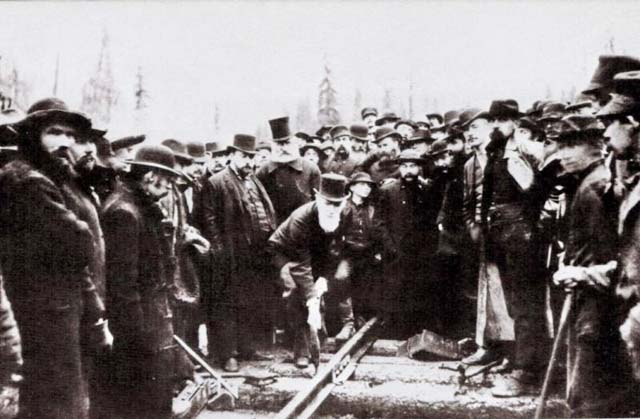

Canad - Canadian noted historical author and TV personality Pierre Berton (1920-2004), called the image "The Great Canadian Photo"
and The Canadian Encyclopedia termed the iconic photo "a symbol of national unity."
The picture is that of Donald A. Smith (Lord Strathcona) driving the ceremonial Last Spike in the Canadian Pacific Railway at Craigellachie, B.C., on
7 Nov 1885, signifying the completion of Canada's first transcontinental railway.
This railroad venture marked the Canadian government's 1871 promise to bring the Province of British Columbia into Confederation.
The "Last Spike" photo, photographer, and Lord Strathcona have deep connections with our Pictou County, going back to the early 1850s.
The photographer of the famed event was Alexander "Alex" James Ross of Pictou, N.S.
The Ross family name has been entrenched in our county and in the northeastern Nova Scotia area ever since the first Ross families arrived on the Ship Hector
in 1773.
In 1861, 12-year-old Alex Ross was living at Water Street in Pictou with his parents Hugh and Ann (McLeod) along with his six brothers and
sisters.
Hugh, the father, was listed as a ship's carpenter, more than likely working down on Pictou's waterfront at Ives, Yorstons, or Irving shipyards.
The creative and "hands-on ability" of this trade must have been passed on to the younger Rosses at an early age.
In the early 1870s, Alex Ross took up the occupation of photographer operating out of the family home.
Photography was becoming a very important and lucrative occupation during the 1850s and 1860s in Canada.
Pictou County was not far behind this trend with Alex offering his photographic services.
Eventually Alex moved out and set up shop at the Irving building on the Pictou waterfront under the designation of A.J. Ross and Company.
Within a short time, Alex's younger brother, John, joined the business forming Ross Brothers Photography, the start of a lifelong career for both in the photos
arts profession.
This Pictou business was also the beginning of a photography franchise that eventually grew to have other studios in New Glasgow, Truro, and
Charlottetown.
(Some early photos of the Ross brothers exist at the McCulloch Heritage Museum in Pictou.)
The brothers became very busy and well known for their portrait sittings throughout their business coverage area.
In 1878 at the Nova Scotia Provincial Agriculture and Industrial Exhibition in Truro, Ross Brothers Photography was presented first prize under the Best
Collection of Photographs category.
This showcase is the forerunner of today's Nova Scotia Provincial Exhibition.
By the early 1880s the Ross Brothers Photography franchise business was dissolved.
And in 1882, Alex left for Illinois, where he married Pictou's Mary MacArthur in Cook County 6 Mar 1882.
The couple travelled on to Winnipeg where they took up residence along with Alex's brothers, Hector, John, and Thomas.
Alex Ross kept his love for photography active and in 1884 joined with John Best to form Ross, Best, and Company.
This business venture became very successful and was advertised as "portrait and landscape photographers."
Their work played a very significant role in capturing Western Canada during its early development.
In 1885 the CPR commissioned Alex Ross to immortalize Donald Smith and the pounding of the "Last Spike," symbolically unifying Canada in the
celebrated historical image.
In 1886, Alex Ross moved to Calgary, formed his own company, and was officially awarded as the "city's first professional photographer."
During the 1880s, Canadian Alex Ross photographed many First Nations people who lived around Calgary.
In particular, Ross documented many of the men, women, and families of the Blackfoot, mainly of the Siksika Nation, and the Tsuu T'ina, or as they were
originally called, Sarcee.
Unlike some of his business rivals, Ross took a growing interest in the local First Nations and between 1884-1891 he started photographing as many of the
indigenous peoples as possible.
He also photographed some of their camps across the Alberta province.
In 1891, Ross unexpectedly closed his business down.
He died three years later in 1894 at 43 years of age.
The Glenbow Archives own 125 of Ross's original photographs, from First Nations people to family portraits, country scenes and livestock, which they describe
as "a brief but important visual record of the last two decades of the 19th century."
After hammering the Last Spike in at Craigellachie, Donald Smith would move on to many of his other business and political ventures.
He was also knighted in 1886 and elected back into the House of Commons in 1887.
Through family connections Sir Donald Smith (Lord Strathcona) would acquire Norway House on Mortimer's Point near the Town of Pictou.
Extensive renovations were carried out by Sir Donald and eventually it was sold after his death in 1914.
Unfortunately, this magnificent historical significant structure was demolished in 2013.
John Ashton.
of the Canadian Copyright Modernization Act.


